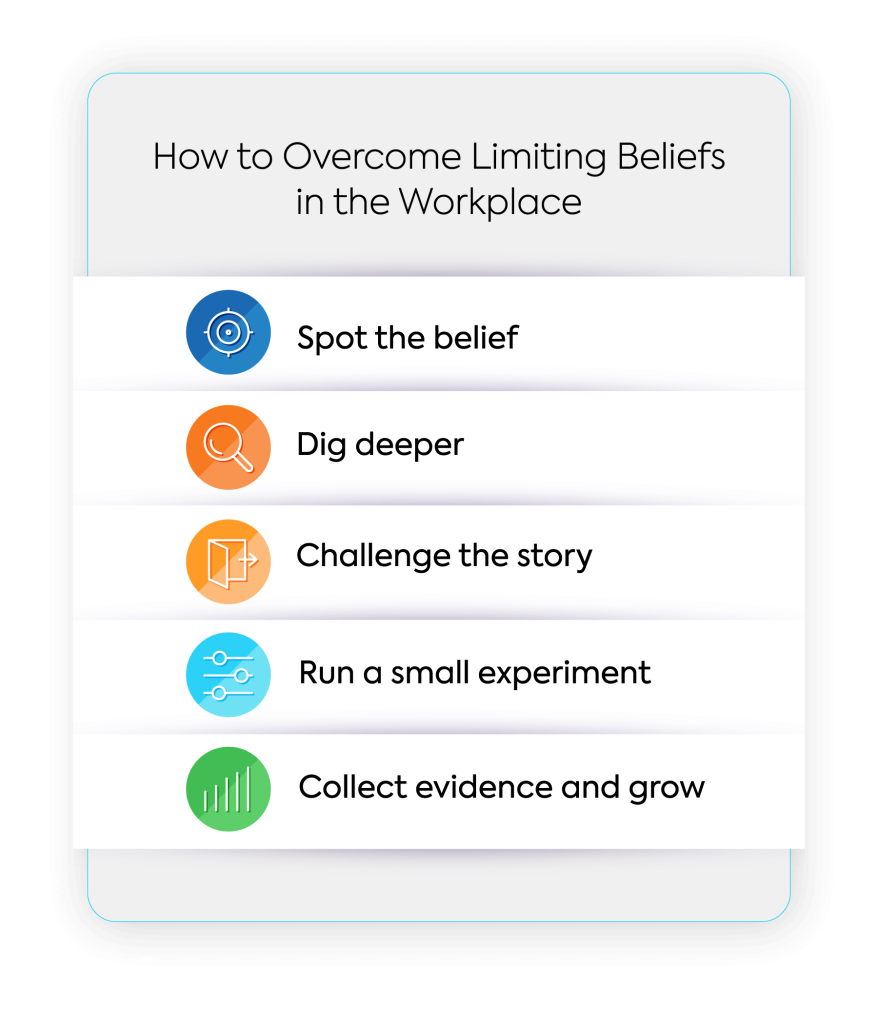Have you ever thought: “I’m not ready for this promotion” or “I never really master speaking in public”?
These negative thoughts are common and often labeled as Limit beliefs.
Sometimes people believe on themselves that are not true. These thoughts can hide in their minds. They don’t even know that they are there. But thoughts can always prevent them from doing well at work. It can happen even if the person is very good in their work.
Imagine a very good chef. They can very well cook, but they believe that they cannot be the boss of the kitchen. They think they were not born to be a leader. For this reason, they do not try to become the chief of chief.
The effect is a direct ceiling on their potential, which affects both the company and overall well-being of employees.
The guide shares useful advice, shows how to identify these common beliefs in your team and gives easy ways to help people change these thoughts. This helps support their Personal growth and happiness as well as their professional development.
What are self-limiting beliefs?

Self-limiting beliefs are thoughts that we say. These thoughts say what we can or cannot do. These are ideas that we believe in ourselves and in the world.
These beliefs are not facts. These are strong thoughts that we believe. Often, we don’t know where they come from and can start things that have happened before. They can come from what others say or what we see in the world around us.
Some people have a strong emotional intelligenceThis allows them to get around a lot of these beliefs, but some are completely consumed by them.
These beliefs are like invisible fences. They guide what we do and prevent us from trying new things. We don’t always notice them. For example, a large sous-chef might think: “I am good for making new dishes. But I am not good at budgeting or managers. So I can’t be a chief chief.
Although this conviction may seem very real for the individual, it is a belief, not a fixed line.
Due to this belief, the chief may not try to work more important. They lack a chance to grow as a leader or further use their cooking skills.
How the limitation of beliefs has an impact on success in the workplace
Self-limiting beliefs act as powerful,, invisible brakes successful.
When these beliefs become stronger, people are starting to say no to good chance. They may not try to promote. They could jump at the head of an exciting project; They stop without even knowing it.
The person may think that he is simply not “cut for that”, whatever their real capacities. People could make a lot of job choices for bad reason. They have the impression that they are not good enough and do not believe in themselves. They therefore choose according to fear, not confidence.
Our talented chef might think: “I am good in cooking, but not to direct or manage money”. Due to this thought, they can lack the chances of growing up. They may not support stocks or share a big idea for a new restaurant. They hold back instead of intensifying.
Therefore, their chances of obtaining steering roles are weaker, not because they lack cooking skills, but because they do not have the necessary management skills.
When people avoid trying new things, they remain in their comfort zone, ultimately limiting their growth. Carol DweckAn expert in mind, says that some people think that their skills cannot change. They feel that they must continue to prove that they are good instead of learning new things.
4 Limit examples of beliefs we often face
Self-limiting beliefs subtly but constantly constantly constantly our professional lives. Often appearing as reasonable thoughts, they can be difficult to spot. Understanding the common models helps to recognize them in ourselves and our teams.
Let’s cross the Four most common examplesAs seen through our chief.
The “not really good” belief
Linked to impostor syndromeBums that achievements are lucky, not skills, breathe the fear of the exhibition. Our chef, who has been rented for a new menu, might think: “A lucky stroke – great ingredients. I cannot reproduce it. They will see that I am not so innovative.” This doubt leads to minimizing success and avoiding projects with high issues.
The belief “I lack essential qualities”
Reflects a fixed state of mind. It is the conviction that vital skills are immutable, and it is missing what is necessary for certain roles. Faced with an important opportunity for GM training requiring a financial meaning, our chef think: “I am a cook, not a person of the figures. You have either this commercial sense, or you do not do it. ” Therefore, they could avoid essential programs for wider leadership.
The belief “it’s too risky, I will fail”
This is rooted in Fear of failure. The apprehension of unbearable consequences can paralyze the initiative. When he is invited to design an experimental menu, our chef thinks: “If it deplores, my reputation suffers. It’s safer to be traditional. ” The result is conservative choices, stifling creative growth.
“Success is not for someone like me”
It comes from Unworthy or self-limitation– A feeling that great achievements are for others. Observing peers of elite schools in the best roles, our head of a local program reflects: “These roles go to chefs with Pedigree. There is a ceiling for my history. ” Such beliefs can reduce professional aspirations.
What makes us have self-limiting beliefs?
Self-limiting beliefs rarely appear overnight.
They are often carefully but unconsciously built from countless experiences of life, such as Passed back, a single sharp criticism or observe the self-limitation models of influential figures.
For example, our chief could trace the reluctance to experiment with daring flavors to an overly severe criticism of an early culinary creation.
The answers learned also play a big role – if people around us avoid risks, we could do the same.
Even well -compared comments, if they are misinterpreted through a self -criticism lens, can consolidate the belief that we are not qualified enough.
The societal stories on talent and success add another layer, subtly shaping who we believe that we can become.
These sons then weave themselves, forming anchored mental cards which define our comfort zones until they are consciously re -examined.
How to prevent self-limiting beliefs in a workplace culture
To stop self-limiting beliefs, we must build a workplace where people believe they can grow.
It starts with a state of growth. It means seeing difficult things like chances of learning. This means that trying is more important than being perfect.
For example, imagine if the chef’s cuisine said: “Trying new dishes is fun and courageous!” Instead of “you have to do things well”. It would help people feel safe to try without fear.
The leaders also help by making the team feel safe. People should feel comfortable to share ideas, ask questions or try new things, even if they don’t succeed immediately.
It is also useful to have training, useful comments and mentors. Hearing real stories of other people who have grown over time can give hope.
Finally, a special Self-limiting belief course can help a lot. These courses are online and people can do them in the form of Autonomous learning. They help break these old unnecessary thoughts that prevent people from growing up.
How to overcome limiting beliefs at the workplace

Internal stories that limit our potential may look like inexpressible truths. However, with deliberate efforts and the right approach, these anchored beliefs can be reshaped, opening the doors to new levels of success and contribution to the workplace.
Locate belief
First, it is necessary to find belief and to really understand its foundations. Go further than name it.
You are deeper
Ask for research questions like:
- When did you start to believe this?
- What specific experiences seem to “prove” that it is true?
- Above all, what is the maintenance of this belief costs you in terms of opportunities or personal growth?
Our chef, for example, could identify belief: “I am not effective in high pressure leadership roles.”
Defy history
Then, by exploring your roots, they could remember a single overwhelming service at the start of their career. Recognize missed opportunities by avoiding such roles clarifies the true impact of belief.
Perform a little experience
With this understanding, the next step consists in consciously conceiving a new stimulating story, then actively living your path through small deliberate actions, almost as carrying out personal experiences.
This could mean manufacturing our chef’s counterfeit: “I strengthen my capacity to effectively carry out pressure by focusing on clear communication and a team delegation.”
Their first test could be to direct the planning of a single part of a large restoration event. They would focus on the delegation of tasks carefully and to let the team update them daily.
Collect evidence and grow up
Regardless of the small size, each successful experience reinforces new convincing evidence, gradually dismantling the old limiting structure and creating a lasting change.
Start building a state of mind of continuous growth
Finding and changing limiting beliefs is not a final destination but a Constant practice of self -awareness and intentional growth.
Promoting environments where this practice is encouraged is a very important Part of the training for learning and development professionals, HR managers and business owners. It is a question of creating spaces where people, like our leader striving with new heights, feel empowered to challenge their own perceived borders.
As Adam Grant Says it wisely: “A brand brand of an open mind does not let your ideas become your identity. He is willing to rethink your hypotheses. ”
Kissing this spirit of rethinking allows people and organizations really really harvesting Benefits of employee training.
This helps them to be resilient, creative and, ultimately, a more dynamic and more capable workforce.
The path to follow is that of continuous learning and courageous evolution.




